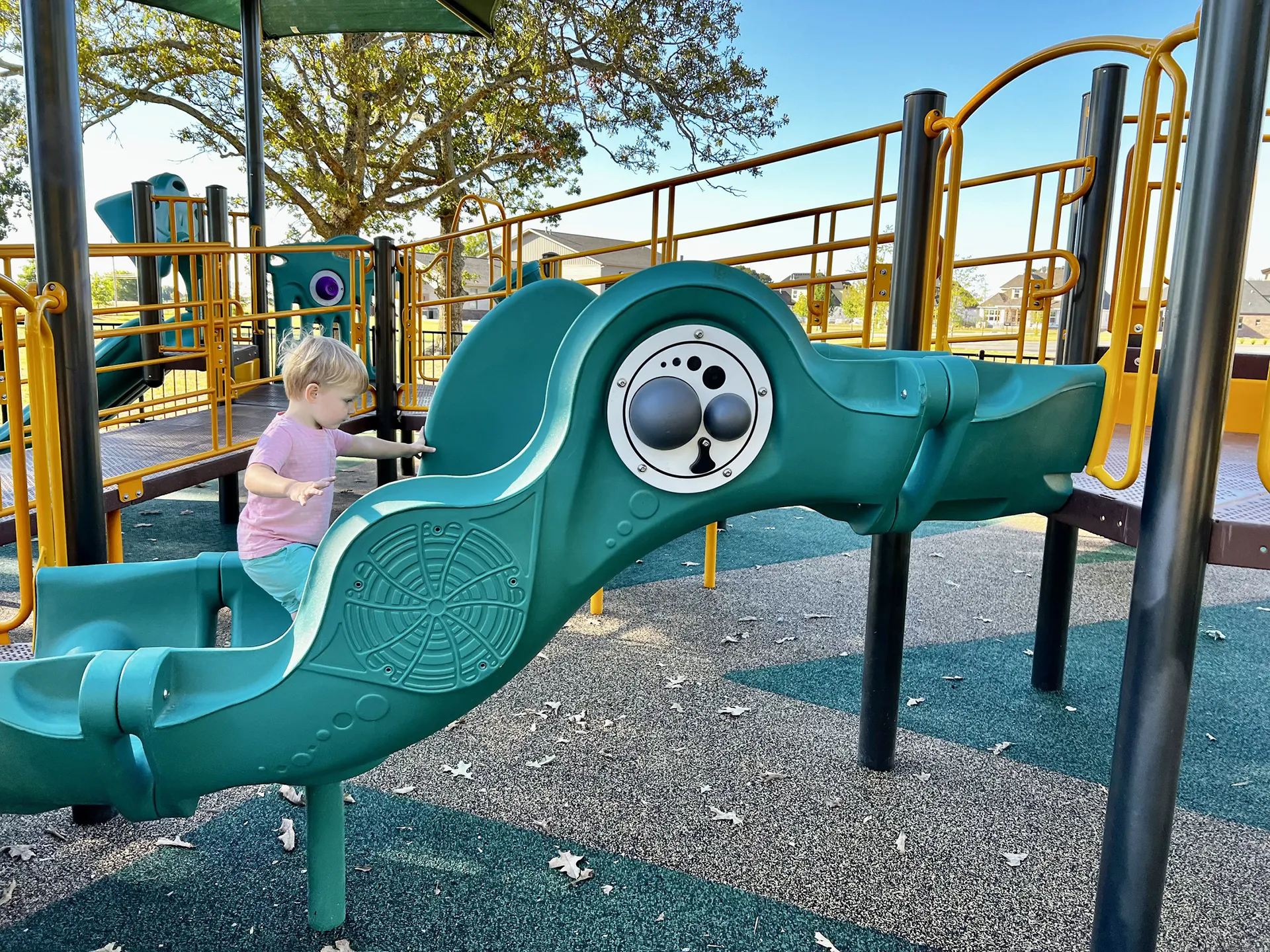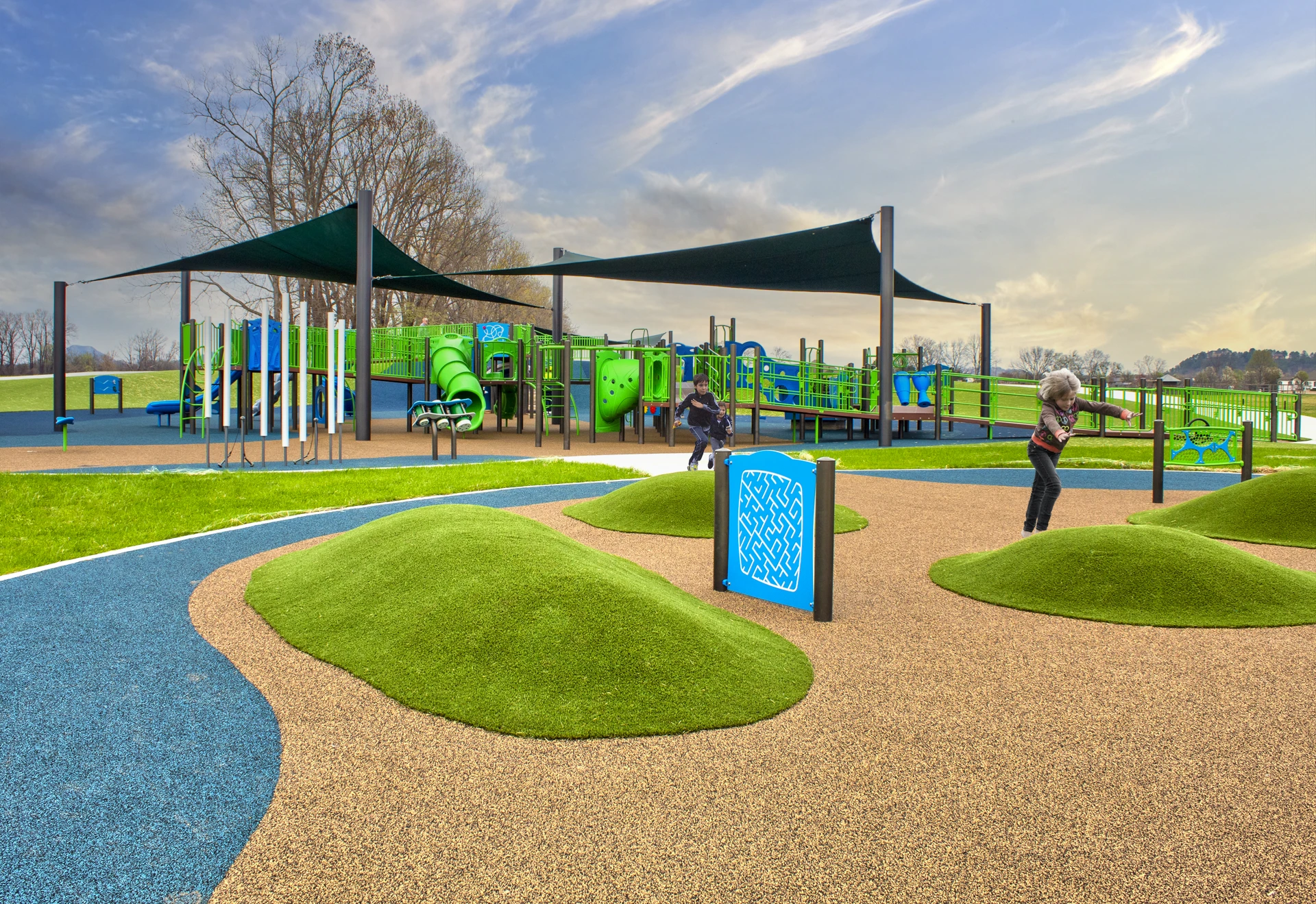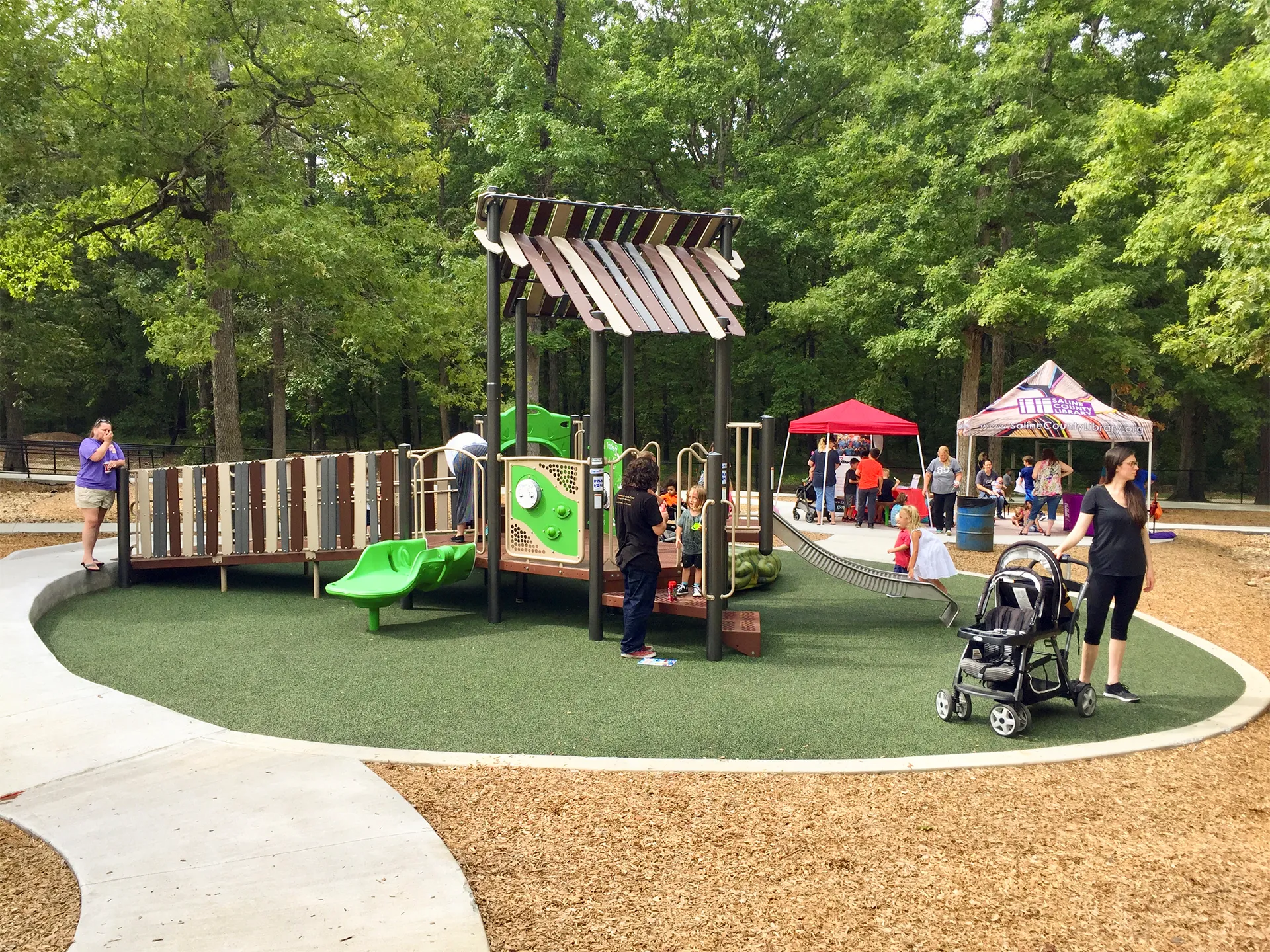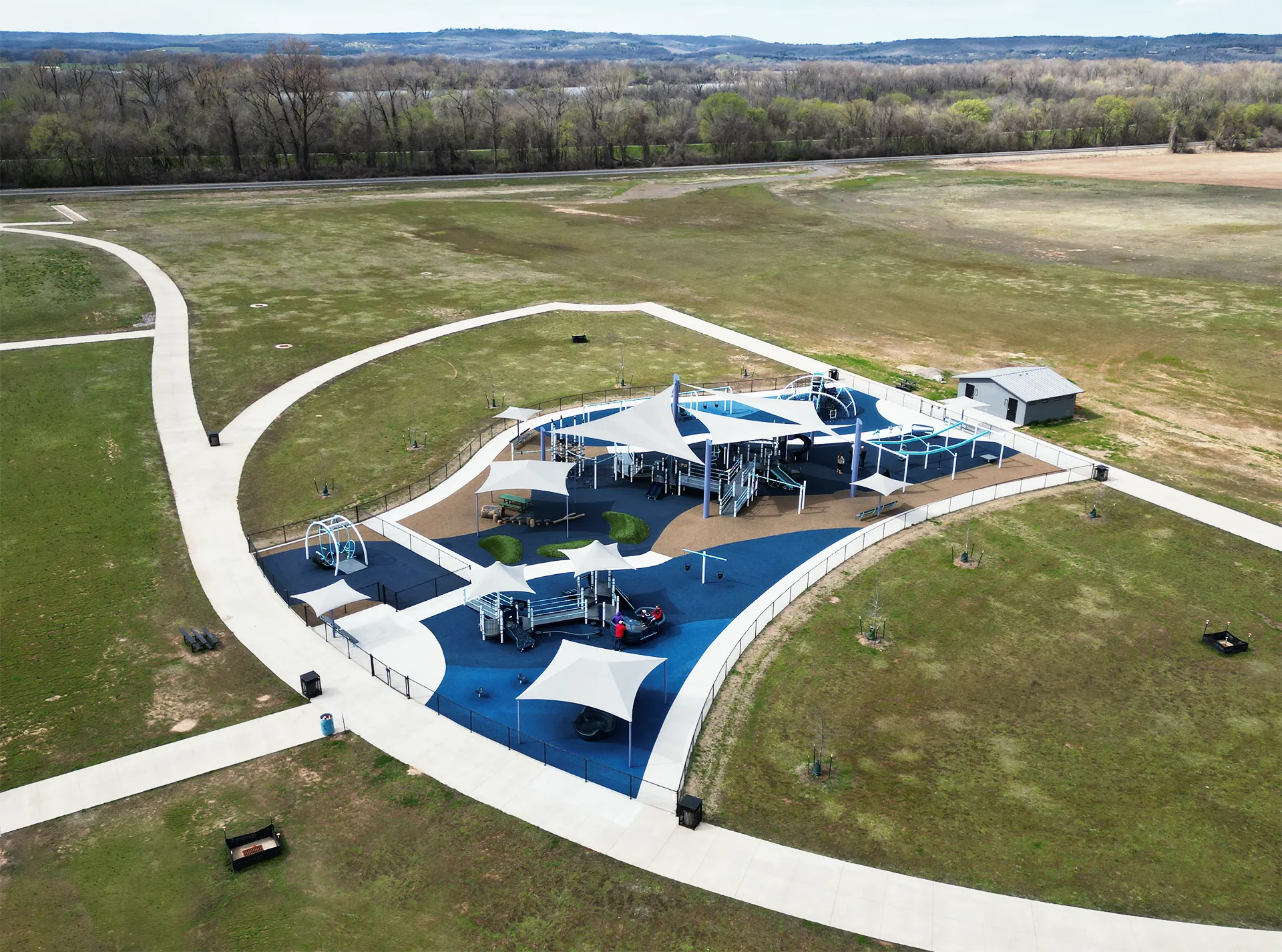
Dave Roberts, PLA, ASLA
Senior Vice President - Planning & Business DevelopmentWhen imagining a playground, most people likely first think of a spiraling slide or a high-flying swing. Of course, play equipment is essential to a playground, but what’s under that equipment is just as important.
A playground’s surface is a critical component worthy of careful consideration during the design process. It’s essential to understand how various surface types impact safety, accessibility, maintenance, and overall aesthetics. A playground with the wrong surface type could create an unsafe maintenance headache with barriers that exclude some children. However, some surfaces can help elevate the playground experience for kids of all abilities.
Inclusive playground at Kathleen Johnson Memorial Park - Lowell, Arkansas
Safety
Unitary surfaces, such as synthetic grass and poured-in-place rubber, are widely considered to be the safest choice because they offer a cushioned floor to lessen the impact of falls. While a cheaper option, loose-fill surfaces like engineered wood fiber do not provide the same impact rating. Additionally, unsafe objects sometimes hide below loose-fill surfaces, and it can be tempting for children to throw or chew the fill material.
Inclusive playground at Two Rivers Park - Little Rock, Arkansas
Accessibility and inclusion
Wheelchairs and strollers move with little to no restriction on rubber and synthetic grass playground surfaces. The same cannot be said for loose-fill options. While engineered wood fiber and rubber mulch meet minimum ADA standards, they do not provide the same ease of movement. Landscape mulch, sand, and pea gravel surfaces are not ADA-compliant and should not be used at public parks and playgrounds.
Inclusive playground at Mills Park - Bryant, Arkansas
Park theme and aesthetics
A playground’s surface can enhance the look and feel of a park and could mean the difference between an environment that sparks play and imagination and one that’s bland. Poured-in-place rubber is popular for its wide-ranging color options and custom design possibilities. It can carry out a park’s theme, highlight walkways and circulation patterns, and add color vibrancy. Imagine a playground with a fishing hole theme. The rubber colors can represent water, sandbars, and even lily pads.
Maintenance
It is crucially important to factor in long-term maintenance costs when evaluating playground surface options. In some cases, the higher upfront costs of poured-in-place rubber and synthetic grass are offset by the reduced maintenance these systems require compared to loose-fill surfaces. Engineered wood fiber is a popular playground option due to its low upfront costs, but it can require frequent topping off and weekly raking to ensure proper depth. It also degrades over time, eventually requiring full replacement.
Douglas Reinert is the director of parks and recreation at the City of Fort Smith, Arkansas. His department is prioritizing lower-maintenance playground surfaces. “There is a higher upfront cost, but poured-in-place rubber and artificial turf have lower maintenance and future replacement costs,” Reinert said. “These surfaces are a long-term investment, and we will continue to move forward with longer-lasting, innovative, and inclusive solutions throughout our park system.”
Crafton Tull recently assisted Fort Smith with two new inclusive playgrounds: an artificial turf playground at Creekmore Park, and a poured-in-place rubber surface playground with artificial turf mounds at John Bell Jr. Park.
INCLUSIVE PLAYGROUND AT JOHN BELL JR. PARK - FORT SMITH, ARKANSAS
“These surfaces are a long-term investment, and we will continue to move forward with longer-lasting, innovative, and inclusive solutions throughout our park system.”
Douglas Reinert
Director of Parks and Recreation - Fort Smith, Arkansas
Recommended surface options
1. Poured-in-Place Rubber
While poured-in-place rubber carries one of the highest upfront costs, parks departments choose to invest in this surface because of its many unique benefits. Its soft surface cushions falls better than other surfaces, providing added safety near tall structures. The rubber subsurface is typically comprised of recycled tires or even shoes. It is wheelchair accessible, durable, and requires little maintenance. The many color and custom design options allow for creativity in the design.
2. Synthetic Grass
Synthetic grass is an increasingly popular choice on playgrounds. It can be used as a standalone surface covering the entire playground or paired with other surfaces to offer visual and textural interest. Several synthetic grass products designed specifically for playgrounds offer high impact ratings for better fall protection. Like poured-in-place rubber, it is wheelchair-accessible, durable, and low maintenance. Some synthetic grass products offer a variety of color options.
3. Other ADA / ASTM Compliant Surface Options
Poured-in-place rubber and synthetic grass are generally recommended over other options, but not all parks departments have the budget for these surfaces. There is no one-size-fits-all solution, and many playgrounds use unitary surfaces combined with loose-fill options to save costs. It is crucial to weigh the lower upfront costs these other surface options may provide, along with their potential drawbacks. Depending on site location, expected number of visitors, and other factors, these options could make sense:
Big investment = Big impact
Choosing a surface is one of the most critical playground design decisions. From a budget perspective, the surface can cost just as much as the playground equipment in some cases. Yet, choosing a cheaper surface option can be more expensive in the long run. Most rubber and turf companies will provide a 10-year warranty on their product. When planning for a playground, careful thought and budgeting should account for each component, including the equipment, surface type, drainage, parking, restrooms, and shade. Consider grants and other funding sources if a playground done the right way seems out of reach. Another option is a phased implementation, which can spread costs over several years.
The physical, emotional, and social benefits of playgrounds are well documented. These places encourage children to move, explore, learn, interact, and grow. The lasting generational impact of a well-designed playground is worth every penny.



